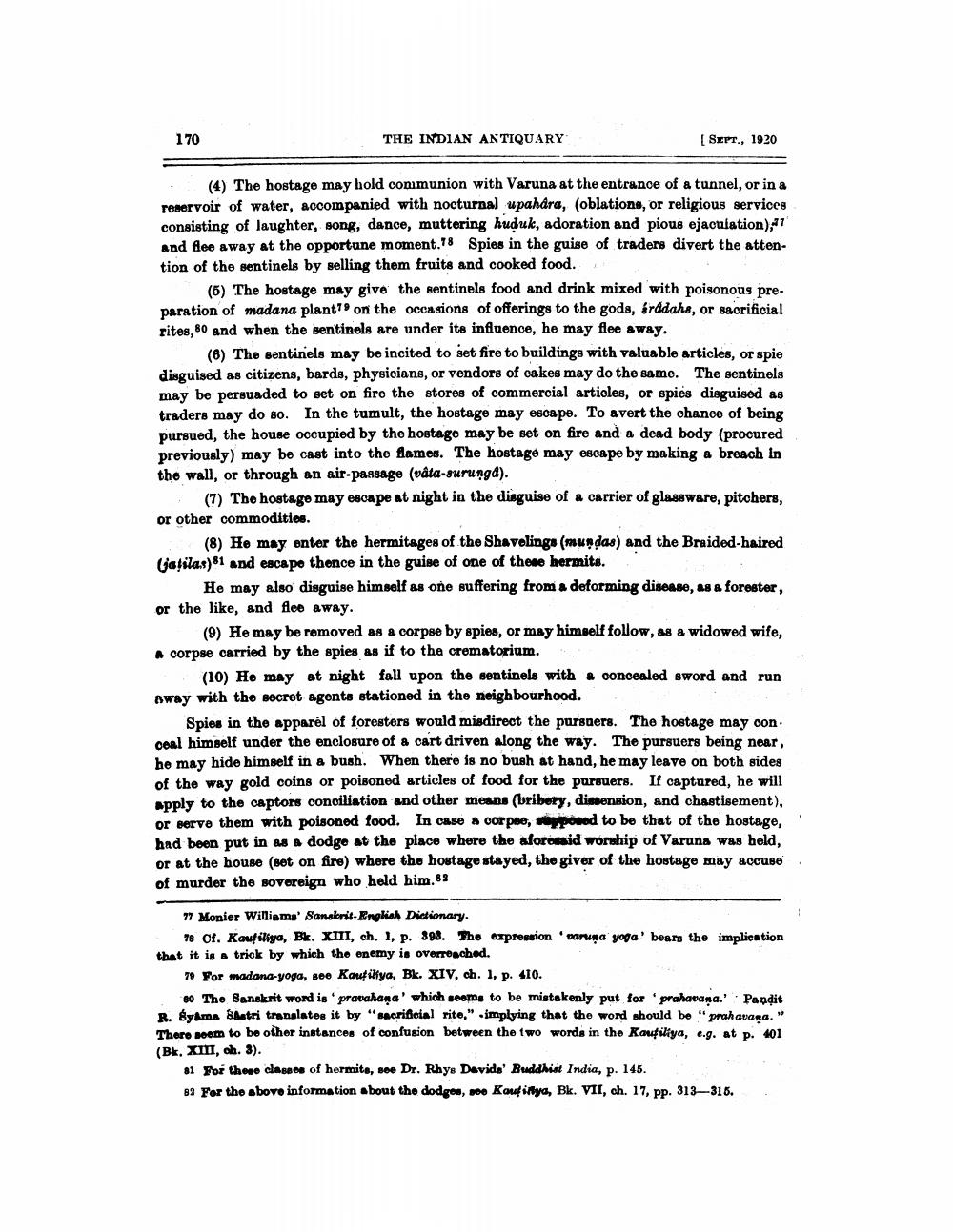________________
170
THE INDIAN ANTIQUARY
[ SEPT., 1920
(4) The hostage may hold communion with Varuna at the entrance of a tunnel, or in a reservoir of water, accompanied with nocturnal upahára, (oblatione, or religious services consisting of laughter, song, dance, muttering huduk, adoration and pious ejaculation): 47 and flee away at the opportune moment.78 Spies in the guise of traders divert the attention of the sentinels by selling them fruits and cooked food.
(6) The hostage may give the sentinels food and drink mixed with poisonous preparation of madana plant on the occasions of offerings to the gods, árddahs, or sacrificial rites, 80 and when the sentinels are under its influence, he may flee away.
(6) The sentinels may be incited to get fire to buildings with valuable articles, or spie disguised as citizens, bards, physicians, or vendors of cakes may do the same. The sentinels may be persuaded to set on fire the stores of commercial artioles, or spies disguised as traders may do so. In the tumult, the hostage may escape. To avert the chance of being pursued, the house occupied by the hostage may be set on fire and a dead body (procured previously) may be cast into the flames. The hostage may escape by making a breach in the wall, or through an air-passage (vâta-surunga).
(7) The hostage may escape at night in the disguise of a carrier of glassware, pitchers, or other commodities.
(8) He may enter the hermitages of the Shavelinge (mundas) and the Braided-haired (jafilas) $1 and escape thence in the guise of one of theme hermits.
He may also disguise himself as one suffering from a deforming disease, as a forester, or the like, and filee away.
(9) He may be removed as a corpse by spies, or may himself follow, as a widowed wife, * corpse carried by the spies as if to the crematorium.
(10) He may at night fall upon the sentinels with a concealed sword and run away with the secret agents stationed in the neighbourhood.
Spies in the apparel of foresters would misdirect the pursners. The hostage may con cual himself under the enclosure of a cart driven along the way. The pursuers being near, he may hide himself in a bush. When there is no bush at hand, he may leave on both sides of the way gold coins or poisoned articles of food for the pursuers. If captured, he will apply to the captors conciliation and other means (bribery, dimension, and chastisement), or serve them with poisoned food. In case a corpse, pored to be that of the hostage, had been put in as a dodge at the place where the aforesaid worship of Varuna was held, or at the house (Bet on fire) where the hostage stayed, the giver of the hostage may accuse of murder the sovereign who held him.83
77 Monier Williams' Sanskrit-English Dictionary.
78 Cf. Kawfiltya, Bk. XIII, ch, 1, p. 393. The expression varuna yoga' bears the implication that it is a trick by which the enemy is overreached.
70 For madana-yoga, see Kaufiltya, Bk. XIV, ch. 1, p. 410.
80 The Sanskrit word ispravahana' which seems to be mistakenly put for 'prahavana.' . Pandit R. Syama Bhatri translates it by “sacrificial rite," .jmplying that the word should be " prahavara.” There soom to be other instances of confusion between the two words in the Kaufiliya, e.g. at p. 401 (Bk, XII, oh. 3).
81 For those dose of hermite, soe Dr. Rhys Davids' Buddhist India, p. 145. 82 For the above information about the dodgoa, s Kaufiftys, Bk. VII, ch. 17, pp. 313-316.




